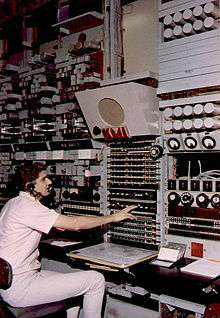AT&T High Seas Service
The AT&T High Seas Service was a radiotelephone service that provided ship to shore telephone calls which consisted of stations WOO (transmitter station in Ocean Gate, NJ (39°55′38″N 74°06′55″W / 39.92722°N 74.11528°W), receiver station in Manahawkin, New Jersey, United States),[1] WOM ([Receiver site in Plantation, Florida 26°8′36.09″N 80°11′55.76″W / 26.1433583°N 80.1988222°W; transmitter on Krome Ave 25°52′21.57″N 80°29′2.44″W / 25.8726583°N 80.4840111°W and KMI (transmitter station in Dixon, California (38°24′38″N 121°46′38″W / 38.41056°N 121.77722°W), receiver station in Point Reyes, California (38°5′31″N 122°57′20″W / 38.09194°N 122.95556°W).
History
Before satellite communication systems were widely available, the only way ships at sea had to communicate with the rest of the world was via radio connections to land stations. To talk to people who did not operate radio equipment, a vessel at sea would make contact with a land station, usually using high frequency AM or single-sideband (SSB) radio. The operator of the land station would patch the radio connection though to a telephone call made over the regular telephone system (referred to as a landline). The AT&T High Seas Service was a commercial radio-to-telephone connection system using the above land stations. The charges were typically settled by making the landline connection a collect call. Larger vessels maintained accounts with AT&T, but the service was available to any vessel with a marine HF radio. In the 1980s the radio link was priced at several dollars per minute plus the long distance landline charge from the High Seas station.
Each High Seas station maintained a radio watch on multiple HF radio channels on multiple marine radio bands. Depending on propagation and distance, the ship radio officer would select a likely band and call ("Whisky Oscar Mike, Whisky Oscar Mike, this is Rollick WSP1234 on channel 604") for the High Seas station listening on that available frequency. Then the High Seas radio technician would ask for the location of the ship and select the antenna oriented in the best direction, or advise a better frequency, or even a better located station to call. Many of the High Seas antennas were fixed Rhombics and the coverage patterns were provided by AT&T to subscribers. While many of the marine HF channels are full duplex (different transmit frequency for ship and ground station), few ships had the radio & antenna capability for duplex operation. Users had to learn to say "over" when done talking and the shipboard radioman would key the transmitter. Since the operator and whole world could listen in, nothing was private in the conversation.
From shore, one could place a call to a ship. The High Seas stations broadcast "traffic lists" on certain frequencies at regular times. The ship radio officer would listen for the ship's name or call letters and then establish the radio link to the High Seas operator, who would then place a landline call to the shore phone number that wanted to call the ship.
Amateur radio operators also provided free phone patch links for ships at sea from licensed hams operating ship radio equipment but only if the message was of a non commercial nature. For many military and maritime service persons, who waited in line for their chance to talk, it was the only affordable way to "call home".

AT&T shut down all three stations on November 9, 1999. Ocean Gate Radio, the home of WOO at Good Luck Point, was made into a Wildlife refuge in 2003. In 2012 it was severely damaged by Hurricane Sandy.[2] In 2016-17 most of the abandoned antenna poles were removed, with the remainder kept as platforms for osprey nests.[3]
References
External links
Globe Wireless Station(Dixon, California) closing [...Formerly AT&T's High-Seas Station: KMI]